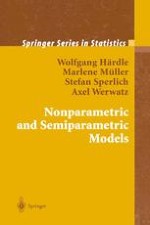2004 | OriginalPaper | Chapter
Generalized Partial Linear Models
Authors : Wolfgang Härdle, Axel Werwatz, Marlene Müller, Stefan Sperlich
Published in: Nonparametric and Semiparametric Models
Publisher: Springer Berlin Heidelberg
Included in: Professional Book Archive
Activate our intelligent search to find suitable subject content or patents.
Select sections of text to find matching patents with Artificial Intelligence. powered by
Select sections of text to find additional relevant content using AI-assisted search. powered by
As indicated in the overview in Chapter 5, a partial linear model (PLM) consists of two additive components, a linear and a nonparametric part: $$ E(Y|U,T) = U^ \top \beta + m(T) $$ where β=(β1,...,β p )is a finite dimensional parameter and m(●) a smooth function. Here, we assume again a decomposition of the explanatory variables into two vectors, U and T. The vector U denotes a p-variate random vector which typically covers categorical explanatory variables or variables that are known to influence the index in a linear way. The vector T is a q-variate random vector of continuous explanatory variables which is to be modeled in a nonparametric way. Economic theory or intuition should guide you as to which regressors should be included in U or T, respectively.
